
Chrysopsis, are plants in the family Asteraceae native to the southern and eastern United States. All the species are found in Florida, although some are found in other states as well.

Heterotheca, are North American plants in the family Asteraceae.

Chloris is a widespread genus of plants in the grass family, the Poaceae, known generally as windmill grass or finger grass. The genus is found worldwide, but especially in the tropical and subtropical regions, and more often in the Southern Hemisphere. The species are variable in morphology, but in general, the plants are less than 0.5 m in height. They bear inflorescences shaped like umbels, with several plumes lined with rows of spikelets.

Heterotheca grandiflora is a species of flowering plant in the family Asteraceae known by the common name silk-grass goldenaster or telegraphweed. It is native to the southwestern United States and northwestern Mexico, but it can be found in other areas as an introduced species, such as Hawaii. It is often a roadside weed even where it is native.
Heterotheca oregona is a species of flowering plant in the family Asteraceae known by the common name Oregon false goldenaster. It is native to the west coast of Canada and the United States in British Columbia, Washington, Oregon, and California as far south as Los Angeles County.

Tolpis barbata is a species of flowering plant in the aster family known by the common name European umbrella milkwort. It is native to southern Europe, including the Mediterranean, and it is known in many other places as an introduced species and a common weed, such as in California and New South Wales.
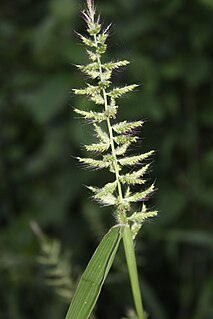
Setaria barbata, with common names bristly foxtail grass, corn grass, Mary grass, and East Indian bristlegrass, is a species of grass in the family Poaceae native to tropical Africa and tropical Asia.

Bradburia pilosa, the soft goldenaster, is a North American species of flowering plants in the family Asteraceae, native to the south-central United States, primarily the southeastern Great Plains and lower Mississippi Valley, in the states of Texas, Oklahoma, Kansas, Missouri, Arkansas, Louisiana, Tennessee, Mississippi, and Alabama. Additional populations are reported farther east but these appear to be introductions.

Heterotheca subaxillaris, known by the common name camphorweed, is a North American species of flowering plant in the family Asteraceae. It is widespread across much of the United States as well as Mexico and Belize.
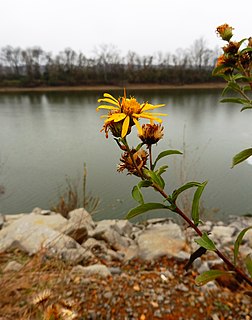
Heterotheca camporum, known by the common name lemonyellow false goldenaster, is a North American species of flowering plant in the family Asteraceae. It is found only in the central United States, primarily the Ozarks, the Cumberland Plateau, and the middle Mississippi Valley. There are reports of additional populations in the Northeast, the Southeast, and in the Great Lakes region, but these appear to be waifs or naturalizations.
Heterotheca fulcrata, known by the common name rockyscree false goldenaster, is a North American species of flowering plant in the family Asteraceae. It has been found in northern Mexico and in the western United States.
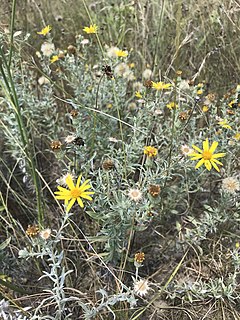
Heterotheca canescens, common name hoary goldenaster, is a North American species of flowering plant in the family Asteraceae. It has been found in northern Mexico and in the Great Plains of the central United States.
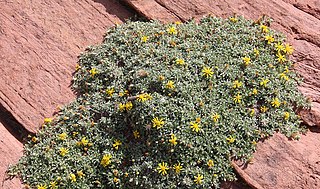
Heterotheca jonesii, known by the common name Jones's goldenaster, is a rare North American species of flowering plant in the family Asteraceae. It has been found in the southern part of the state of Utah in the United States.
Heterotheca marginata, the Sonora false goldenaster, is a rare North American species of flowering plant in the family Asteraceae. It grows in Arizona in the southwestern United States. It has been found in only three counties in the south-central part of the state: Maricopa, Pinal, and Gila.
Heterotheca pumila, the alpine goldenaster, is a North American species of flowering plant in the family Asteraceae. It grows in alpine and subalpine regions in the mountains of the western United States. It has been found the Rocky Mountains in Wyoming, Colorado, Utah, and New Mexico.

Heterotheca rutteri, the Huachuca goldenaster or Rutter's false goldenaster, is a rare North American species of flowering plant in the family Asteraceae. It has been found only in the Huachuca and Santa Rita Mountains of southern Arizona and northern Sonora.
Heterotheca stenophylla, called the stiffleaf goldenaster, is a North American species of flowering plant in the family Asteraceae. It grows on the Great Plains of the central United States from South Dakota south to Texas and New Mexico.
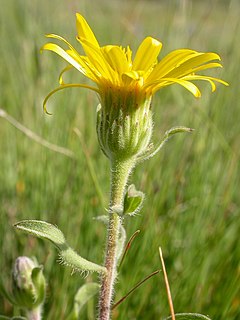
Heterotheca villosa, called the hairy goldenaster, is a North American species of flowering plant in the family Asteraceae. It widespread across the central and western parts of the continent, from Ontario west to British Columbia and south as far as Illinois, Kansas, Nuevo León, Guanajuato, and northern Baja California.
Heterotheca viscida, called the cliff goldenaster, is a North American species of flowering plant in the family Asteraceae. It grows on cliffs and ledges in mountainous regions. It grows in the southwestern United States, primarily in Arizona, New Mexico and southern Texas with reports of isolated populations in Nevada, southeastern Idaho, and southeastern Colorado.
Heterotheca zionensis, the Zion goldenaster, is a North American species of flowering plant in the family Asteraceae. It grows in Utah, Arizona, New Mexico and western Texas. The plant has also reportedly been found in southeastern Idaho and northwestern Colorado, but these are most likely introductions.












